Artificial intelligence (AI) has promising potential for enhancing learning management systems (LMSs). When correctly applied, AI can automate and streamline content management, create personalized curricula and training sessions, improve student engagement, and more. The trick is to determine which LMS features can benefit from AI enhancement.
In this article, we discuss how you can use AI to improve your LMS, overview which capabilities can be enhanced, and share our best practices for enhancing your eLearning platform with AI.
This article will be useful for organizations that plan to develop an AI-based learning management system from scratch or enhance an existing LMS with AI capabilities.
Contents:
How can AI enhance your LMS?
Artificial intelligence is no longer a fancy and overly expensive technology. Instead, it’s a useful tool that enhances and automates lots of business activities. The global Learning Management System (LMS) market is projected to grow from $18.26 billion in 2023 to $47.47 billion by 2030, boosted by increasing demand for eLearning.
The explosive growth of generative AI development and end-user tools is also redefining personalized learning experiences. These tools not only enhance real-time feedback but are introducing new trends like video-based learning and AI-powered learning paths.
Enhancing software with AI helps businesses generate revenue or improve services by automating routine tasks and speeding up the analysis of large amounts of data. When applied in an LMS, AI capabilities can improve system performance and make your product more competitive. For example, you can achieve the following benefits from an AI LMS platform:
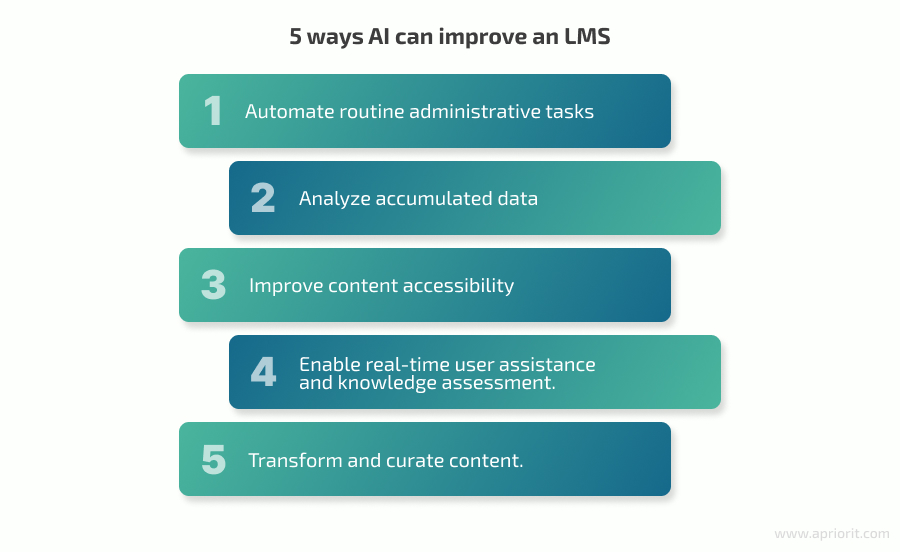
Automate routine administrative tasks. Managing an LMS is time-consuming. It involves scheduling lessons, monitoring users, processing requests for technical support, and other monotonous and repetitive processes. To handle them, you can implement AI modules that are capable of:
- Creating personalized and complex curricula
- Helping users resolve common issues
- Tagging and categorizing learning content
- Generating personalized reports
- Onboarding teachers and students
Analyze accumulated data. An LMS collects tons of data on students’ progress, scores, studying challenges, common issues with the system, and so on. This information can provide valuable insights to an organization that uses an LMS, but it can be hard for a human to analyze such massive amounts of data. An AI system, on the other hand, can process tons of information much faster than a human and can detect unobvious insights.
Improve content accessibility. AI in LMS can accelerate the process of translating learning content and adapting it for other languages and cultures. Tutors can then review the reworked content. Also, AI can make educational tools more convenient for users with disabilities by reading content, describing it, or writing down student responses during tests.
Enable real-time user assistance and knowledge assessment. With remote education, students experience a lack of real-time connection with tutors, especially outside lectures. If they have questions or need to discuss assessment results, they can’t do it right away. AI can fill this communication gap by providing real-time answers to simple questions and helping students resolve issues. It can also analyze students’ responses, provide personalized feedback, and recommend training courses.
Transform and curate content. The more content an LMS accumulates, the more effort tutors and administrators have to put in to keep that content relevant, easy to use, and accessible on various operating systems and devices. AI can adapt content, analyze which lectures may need updates, and alert tutors about this need. And AI can do it faster and more efficiently than a human or a predetermined algorithm.
Moreover, AI can take a given piece of content and adapt it to create custom learning sessions for corporate training, for instance. Compared to students, employees have even less time to study, so they need short and efficient training sessions. AI can analyze an employee’s capabilities, needs, and goals and transform existing content into a series of short lectures.
Enhancing these LMS tasks with AI sounds promising and beneficial both for the organization that uses an LMS and for developers. Organizations can improve their services by introducing AI, and developers can create cutting-edge and competitive products faster. However, not all LMS features need to be improved with AI.
To save your time and development budget, we’ve created a list of features that will most benefit from AI integration. Let’s take a look at them in the next section.
Get started with AI development today!
Contact us to discuss creating an AI solution that’s right for you.
Top LMS functionalities to enhance with AI
Having an efficient and user-friendly learning management system is a must for any organization that provides educational services, whether they teach students or their own employees. Building an artificial intelligence–powered learning platform or improving your existing LMS with the help of AI allows you to take teaching services to another level.
With the great variety of possible improvements offered by AI, it’s not easy to pick which features to enhance first. When choosing technologies to build an AI-based learning management system, consider these factors:
- What tasks do you need to solve with the help of AI?
- How many resources can you allocate to build a custom LMS with AI features?
- Are there any ready-made AI models and solutions available that you can adopt and improve?
Pay special attention to the following functionalities when building an AI-powered LMS:
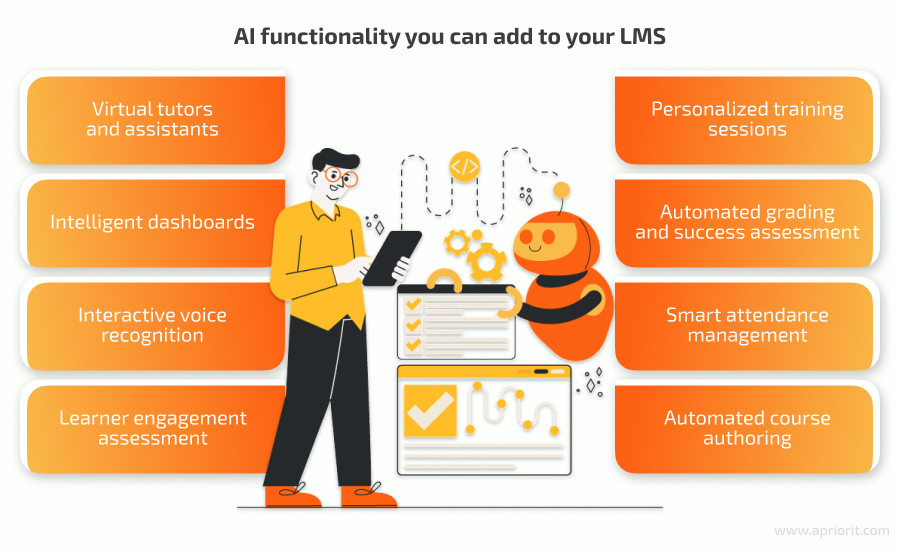
1. Virtual tutors and assistants. Traditional student assistance in an LMS relies on a preset list of questions and answers. Adding AI capabilities helps an LMS understand unusual requests, provide answers that are more relevant to the questions, and create an experience that approximates communication with a real person. For example, Cognii uses AI to process open-format responses and provide students with one-on-one learning any time they need.
Virtual assistants are usually powered by AI chatbots that employ machine learning algorithms, text analysis, and natural language processing (NLP). Some teams use voice generation to provide voice assistance during AI chatbot development. More elaborate virtual tutors also use AI to generate a 3D model of a teacher in virtual reality.
Read also
Artificial Intelligence in the Automotive Industry: 6 Key Applications for a Competitive Advantage
Explore uses of AI and machine learning for the automotive industry to improve manufacturing, increase supply chain efficiency, and make the driving experience safer.

2. Interactive voice recognition. Voice assistance is particularly important for learning new languages, teaching people with writing and reading impediments, and teaching kids who can’t read and write yet. To interact with such students, an LMS needs to be able to read text aloud, recognize students’ speech, assess it, and respond.
AI can efficiently perform these tasks by combining speech recognition, NLP, and voice generation. Keep in mind that you don’t always need to enhance all processes related to oral communication with AI. For example, you can teach an LMS to form questions in English using rule-based automatic question generation [PDF] algorithms.
3. Personalized training sessions. AI can now offer personalized educational paths by analyzing student behavior, course interactions, and learning styles, going beyond simple tutoring. The educational process is more efficient when it’s adjusted to the needs and wants of a certain learner. While a traditional LMS provides some adjustment options when choosing a training course, AI makes this process more flexible and personalized.
Using predictive analysis and cognitive neuroscience will help you build platforms like Century Tech. It uses AI to personalize training sessions by gaining insights into learners’ performance, achievements, and qualifications. You can also use predictive analysis to automate course selection and scheduling. Predictive analysis does all the work for teachers by evaluating a student’s learning path and suggesting relevant courses.
4. Smart attendance management. Monitoring student attendance at remote lectures takes time and effort. Also, some students may cheat by attending only the start of an online class. One way to solve this issue is by proving attendance with biometric checks. But this solution can be rather expensive since all students will need some sort of biometric scanner.
AI algorithms for image recognition provide a more elegant solution. With a collection of student photos as a dataset, AI can detect students’ faces in a video feed. It can also calculate attendance time, making it impossible for students to cheat.
Read also
Emotion Recognition in Images and Video: Challenges and Solutions
Learn how you can overcome video- and image-based emotion recognition challenges with the help of AI.

5. Intelligent dashboards. Classifying and analyzing data gathered by an LMS can help you understand how users interact with it and find opportunities for improvement. For example, you can create dashboards with students’ performance, the most requested training courses, the average length of a training session, the most common questions and issues, etc.
Powering such dashboards with AI-based predictive and prescriptive analytics helps you not only overview historical data but also discover patterns in the way students study and optimize training courses.
6. Assessment of learner engagement. The level of a learner’s engagement may indicate issues with a training course, the poor quality of educational materials, issues with a tutor, etc. However, this metric is particularly hard to assess in online education. Traditional methods of assessing engagement, such as interviews and surveys, can’t always show real engagement issues.
Deep learning algorithms can calculate engagement based on a learner’s history of interactions with the LMS and educational content. They can also compare interactions with the peer group, suggest reasons for changes in engagement, and propose improvements.
Read also
Building an Interactive Voice Response System with Twilio: Platform Overview
Check out how you can combine Twilio with the power of AI for interactive voice response systems.

7. Automated grading and success assessment. This automation can significantly reduce the workload for educators, allowing them to focus on providing more personalized instruction and support for students.
AI can automate grading for certain types of assignments, quizzes, and tests by analyzing and evaluating written responses, multiple-choice questions, and even creative submissions like essays or designs.
8. Automated course authoring. AI-powered tools can assist in generating course content, assessments, and even entire modules by analyzing existing materials, structuring information, and providing suggestions for improvement.
However powerful it is, AI is not without its limitations and can’t successfully tackle all the challenges of online education. Let’s see when it’s best to choose other technologies during AI-based LMS platform development.
Limitations of AI within educational platforms
Just like any technology, AI has its weaknesses. Below, we overview key limitations to consider before deciding to add AI capabilities to your learning management system.
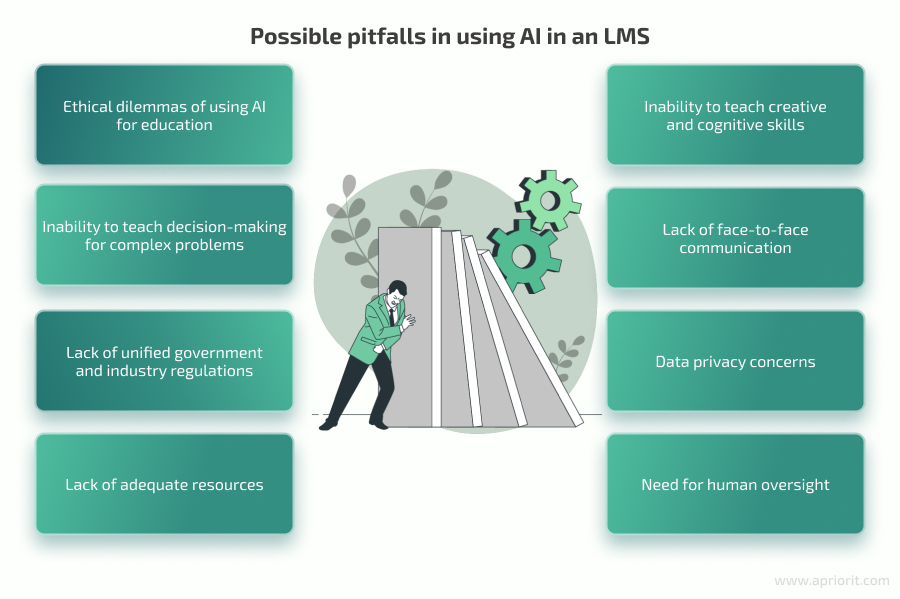
Ethical dilemmas of using AI for education. The very idea of substituting human tutors with AI raises many concerns because of biases built into algorithms. Key ethical issues include:
- Risk of discrimination. AI developers train their algorithms using data from a large group of people. However, if trained on a poorly balanced dataset, an AI model may overlook the needs of people with different educational and cultural backgrounds and various disabilities.
- Poor adjustment to cultural specifics. Adjusting training courses to learners’ cultural and national backgrounds is important for any organization, but especially an international one. Yet an AI system has a hard time taking into account such differences if it wasn’t specifically trained to do so.
- Total surveillance over learners. To create personalized training sessions, AI has to analyze data on each learner’s activity in the LMS. Some end users can be suspicious of close monitoring and constant data collection, so they need to be assured that the LMS has strong cybersecurity and data anonymization mechanisms.
Inability to teach creative and cognitive skills. As Will Smith’s character from I, Robot says, a robot can’t write a symphony or create a masterpiece. Well, it can, but only by analyzing other symphonies and creating something similar. That’s why there’s no point in trying to use AI to enhance educational courses aimed at developing creative traits or teaching students how to study by themselves.
Inability to teach decision-making for complex problems. In areas with a high level of responsibility, like healthcare, engineering, or manufacturing, it’s best to combine the possibilities of AI algorithms and human teachers. AI can analyze data and provide possible solutions to an issue, but it’s up to a human to assess them and choose the most suitable option. And a teacher can explain how to do this much better than AI.
Lack of face-to-face communication. Digital tutors, 3D models, and virtual reality can simulate real-life communication, but it still feels artificial to any human. A face-to-face discussion usually helps learners study more efficiently [PDF]. Also, emotional connection, motivation, and praise for good work usually improve student performance. Hence, your LMS should provide various ways for teachers and students to communicate.
Lack of unified government and industry regulations. As with many new technologies, there are so far very few laws and regulations on the use of AI in education. Most countries are only now working on them.
- In 2023, UNESCO released “Guidelines for the ethical use of artificial intelligence in education,” which provide recommendations for governments, educational institutions, and AI developers on how to use AI responsibly in education.
- The European Union’s proposed AI Act, which is currently in progress, includes provisions for regulating the use of AI in education. The Act aims to ensure that AI systems used in education are safe, fair, and unbiased.
- In the United States, the Department of Education released a report in 2023 that discusses the potential benefits and risks of AI in education and recommends that policymakers take a cautious and pragmatic approach to regulating AI technologies.
For AI developers, this means figuring out their own way to implement AI into their software in a secure, reliable, and unbiased way.
Data privacy concerns. With the increasing use of AI, concerns about data privacy and security have escalated. Educational institutions need to be vigilant in protecting sensitive information and implementing data management practices to safeguard students’ personal data. These practices can include anonymizing data, granting access only to authorized personnel, and following data protection requirements.
Lack of adequate resources. Advanced AI algorithms require substantial computational power, which might not be realistic for all educational institutions. The cost of hardware, software, and ongoing maintenance can be prohibitive for smaller institutions with limited budgets. Additionally, the expertise required to manage and operate AI-powered LMSs may not be readily available for all institutions.
Need for human oversight. Despite advancements, AI still requires human oversight to guarantee the quality, fairness, and effectiveness of AI-powered LMSs. AI algorithms are not infallible and can produce biased or inaccurate results. Human experts must carefully review AI-generated content, assessments, and recommendations to ensure they align with educational objectives and are free from bias.
Now that you know about the strong and weak points of adding AI to your learning management system, let’s see the best practices for developing an AI-based LMS based on our experience.
Related project
Building an AI-based Healthcare Solution
Learn how we helped our client leverage AI to create a solution that could track ovarian follicles across video frames, detect them in ultrasound images, and measure them.

Best practices for enhancing an LMS with AI
Developing an AI-based learning management system requires a great deal of caution and expert knowledge of both the technology and hidden obstacles in the development process. Here are some tips on how to improve the development process:
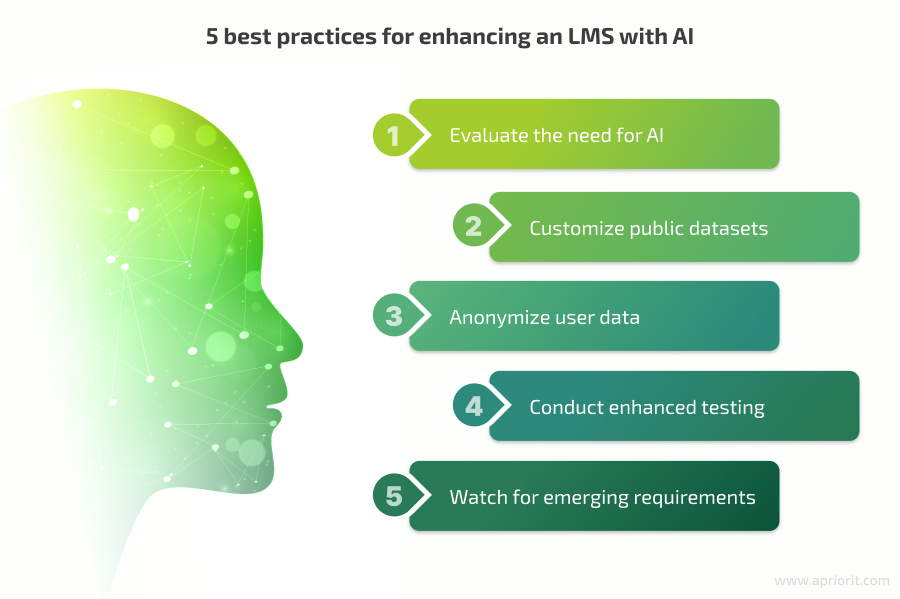
1. Evaluate the need for AI. Though AI can automate and improve many educational activities, that doesn’t mean that it should. Adding AI to any possible LMS functionality also adds to the software development time and budget. That’s why it’s best to analyze end users’ needs and the educational process before planning AI enhancements.
For example, virtual assistance and knowledge testing are popular features in an AI-based LMS. However, it will be inefficient to implement these features into solutions with simple, straightforward navigation systems and no need to process unusual requests.
2. Customize public datasets. Preparing data for training an AI LMS algorithm is the key to its correct work. Collecting, labeling, and classifying all this data from scratch is extremely time-consuming, but you don’t always have to do it. Instead, you can search for quality public datasets that more or less fit your goal and adjust them for your needs.
To customize a public dataset, you need to collect, sort, and label data of your users that has already been collected by your LMS. If you lack data on particular types of students, activities, etc., you can use AI to generate new records similar to the ones you already have. This way, you can get more training data and reduce the possibility of creating a biased AI model.
You can start with this list of free datasets that have collections for educational software in general, image processing, NLP, machine learning algorithms, and more. Customizing these datasets will help you speed up development and save the project budget.
3. Anonymize user data. Data privacy and security in AI-based software cause a lot of concerns because such solutions use lots and lots of real user data. Moreover, they accumulate data while they work. To protect it and alleviate ethical and legal concerns, you need to anonymize the personal records that AI uses. Anonymized data doesn’t contain any personally identifiable information and, therefore, can’t violate anyone’s privacy.
To anonymize data, you can apply generalization, perturbative and non-perturbative masking, local suppression, and other techniques.
4. Conduct enhanced testing. Testing of AI-based solutions shouldn’t be limited to usual functional and non-functional tests. You also need to ensure AI algorithms have as few biases as possible. Developing a completely objective system is impossible — it will always reflect the views of developers, people who prepared the dataset, or people whose data the dataset contains.
We can be blind to our own biases. That’s why it’s worth testing your solution on several diverse datasets and periodically assessing its work. This is especially important during custom AI-based LMS development for a large-scale organization that needs to educate people from different cultures and with different upbringings, religions, etc.
5. Watch for emerging requirements. Many governments are discussing policies for applying artificial intelligence in schools, universities, and private training. Once applicable national or industry laws, regulations, or standards are released, you’ll need to adjust your software to meet them. That’s why it’s best to start paying attention to policy discussions now and take them into account while building an AI-based LMS. Also, keep in mind that you still have to comply with the GDPR, NIST SP 800-53, ISO 27001, and other general-purpose IT regulations, standards, and laws.
How can Apriorit help you improve your LMS with AI?
Our team is ready to help you with your artificial intelligence and machine learning needs. We have experience working with custom eLearning projects and complex SaaS solutions, including AI-based platforms.
You can leverage the experience of Apriorit’s team of AI engineers and data scientists in all aspects of the AI development lifecycle, from ideation and prototyping to deployment and maintenance.
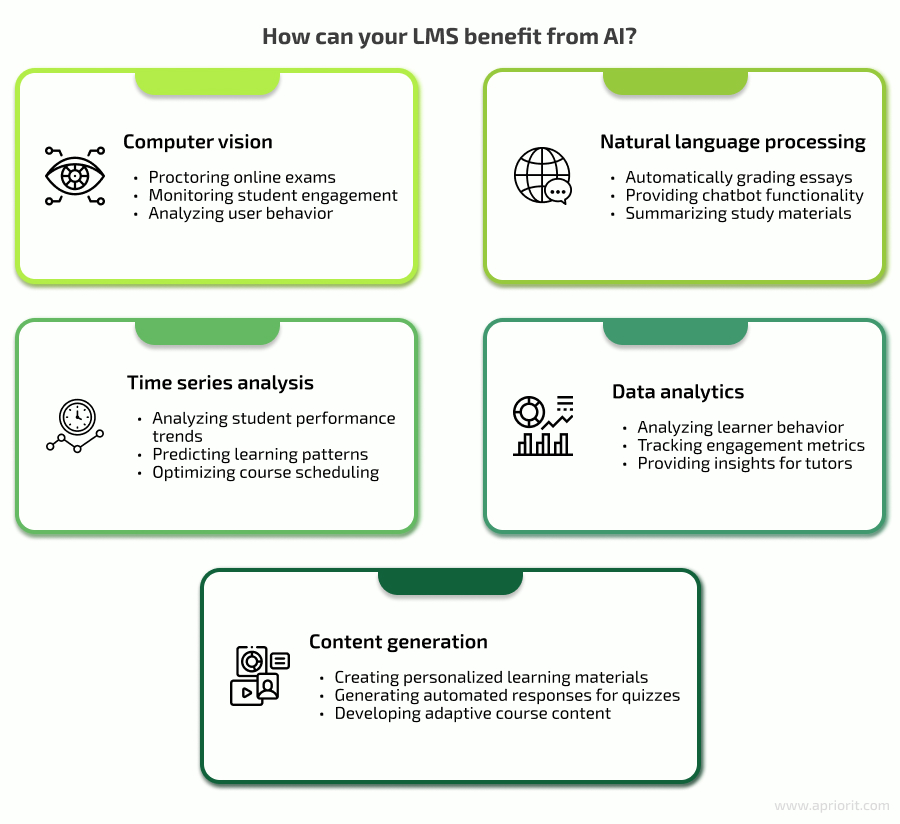
At Apriorit, we have a proven track record of delivering innovative and effective AI solutions to clients across a wide range of industries, including eLearning. By partnering with our company, you will benefit from:
- High accuracy of AI solution results
- Full compliance with local and industry-specific IT standards and requirements, including the GDPR
- Improved user experiences across your platforms
- Boosted cybersecurity posture for your products and company in general
Together, we can harness the power of AI to transform your operations, achieve your strategic goals, and unlock new possibilities for your business. To learn more about implementing AI into your solutions, check out our article about 12 questions to ask before starting an AI project.
Conclusion
AI can help organizations take their educational experiences to the next level. With relevant technologies and development approaches, you can make AI perform management tasks, rework and adapt content, help students, and more. Most importantly, building an AI-based LMS frees up the time that your employees usually spend on simple routine activities and allows them to focus on challenging issues.
Choosing relevant technologies and development approaches helps you reduce the project cost, release your software faster, and make sure that it fits the needs of your customers. That’s why it’s worth getting an expert AI development team like ours to create an intelligent LMS.
Looking to gain a competitive edge with innovative AI solutions?
Reach out for a personal consultation on how to develop your AI-based learning platform!


